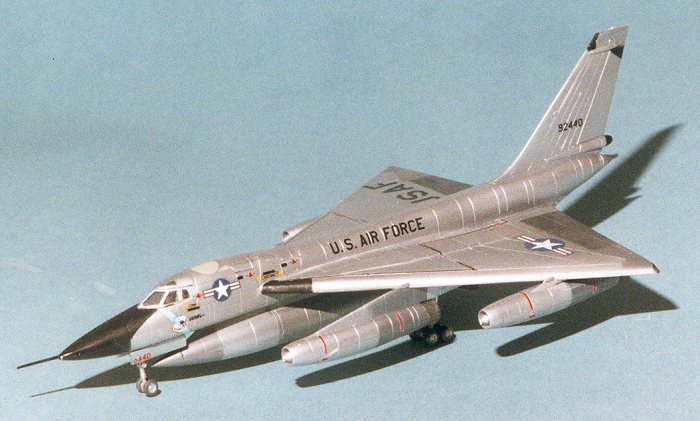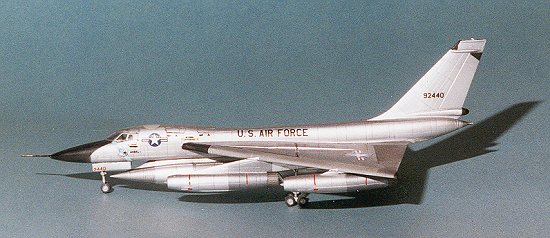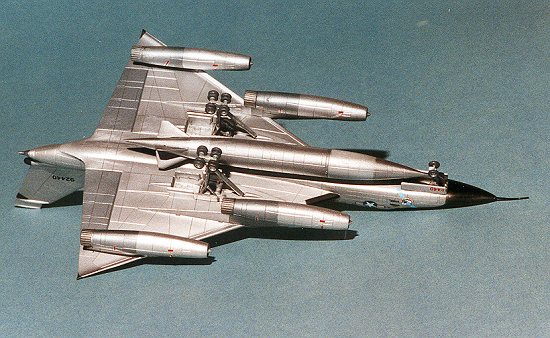
Hobbycraft 1/144 B-58A Hustler
|
KIT # |
1260 |
|
PRICE: |
$20 |
|
DECALS: |
Two options: 6592 TS, 1962 and 43BW, England, 1969 |
|
REVIEW : |
Drew Nix |
|
NOTES: |
|

|
HISTORY |
"Faster, farther, higher" seemed to be the motto of the U.S. Air Force in the 1950's and 60's. Tactical Air Command had some of the fastest fighters in the world at that time including the Convair delta-winged F-102A "Delta Dagger" and F-106A "Delta Dart". Since the Soviet Union also had supersonic interceptors, the Strategic Air Command wanted a bomber that could deliver a nuclear punch at supersonic speeds, hopefully outrunning any interceptors the Soviets would be able to send against it.
In the late 1950's a proposal for just such a bomber was issued by the Air Force to the major aircraft manufacturers. Convair beat out Boeing for the contract with their futuristic looking B-58. Using the delta-wing planform that was based on research conducted by Dr. Alexander Lippisch during and after World War II, and had already been proven with the F-102 and F-106, Convair proceeded to build the fastest bomber in the world.
 The B-58, with its stalky landing gear and podded payload presented an unmistakable silhouette either on the ground or in the air. Unfortunately, it was ahead of its time. It was a handful to fly, even for the most skilled pilot, who had to be constantly thinking ahead or the aircraft could get away from him, especially when taking off. They seemed to crash with alarming regularity! This and the fact that the Soviets made tremendous strides in anti-aircraft missile technology during the 1960's meant that the B-58 was only in service a short ten years between 1960 and 1970. During that period it set several speed records for bomber aircraft.
The B-58, with its stalky landing gear and podded payload presented an unmistakable silhouette either on the ground or in the air. Unfortunately, it was ahead of its time. It was a handful to fly, even for the most skilled pilot, who had to be constantly thinking ahead or the aircraft could get away from him, especially when taking off. They seemed to crash with alarming regularity! This and the fact that the Soviets made tremendous strides in anti-aircraft missile technology during the 1960's meant that the B-58 was only in service a short ten years between 1960 and 1970. During that period it set several speed records for bomber aircraft.
On a personal note, I grew up in LA (Lower Arkansas). For most of its career a wing of B-58s was based at Little Rock Air Force Base. Two things I remember as a teenager growing up during those years: the frequency that the state newspaper reported spectacular crashes involving Hustlers and the sonic booms. Many a warm summer evening I would be at the baseball field when, high above, I could see the contrail of an aircraft moving quickly. At the head of that contrail would be the unmistakable arrowhead shape of a B-58. I knew what was coming next, the "boom, boom" of an aircraft breaking the sound barrier. Ah, those days are long gone, but not forgotten!
|
THE KIT |
Released last year by Hobbycraft, the 1/144 scale B-58A was a welcome, and surprising, addition to the "teensy" scale. Molded in the now ubiquitous light gray plastic, the kit contains over sixty pieces. Detail is surprising good and all panel lines are engraved. The delta wing comes as one piece with the correct anhedral molded into the wingtips. Two versions can be built, an unarmed trainer version or a regular B-58 with the MB-1 weapons pod and 20mm Gatling gun tail stinger.
|
CONSTRUCTION |
 The kit has a fairly complete interior for this scale. The pilot, offensive weapons officer, and defensive weapons officer's encapsulated seats are all provided along with the bulkheads separating the various positions. I painted the interior Dark Gull Gray, FS 36231, using Testors Model Master paint. The interiors of the escape capsules were painted gloss white with the seat cushions being done in Testors Model Master Green Drab. The kit does provide some sidewall details. These were painted flat black then a white artist's pencil was used to pick out the details. The seats and bulkheads were glued to the cockpit floors, then these assemblies were glued to the right fuselage half.
The kit has a fairly complete interior for this scale. The pilot, offensive weapons officer, and defensive weapons officer's encapsulated seats are all provided along with the bulkheads separating the various positions. I painted the interior Dark Gull Gray, FS 36231, using Testors Model Master paint. The interiors of the escape capsules were painted gloss white with the seat cushions being done in Testors Model Master Green Drab. The kit does provide some sidewall details. These were painted flat black then a white artist's pencil was used to pick out the details. The seats and bulkheads were glued to the cockpit floors, then these assemblies were glued to the right fuselage half.
The two fuselage halves are glued together next. The tail is molded into the right fuselage half. A good idea except that it gave a nasty seam that was difficult to fill without losing surrounding surface detail. After the seams were filled and sanded, the cockpit combing was painted flat black before the windscreen was added. Hobbycraft gives the whole front canopy as a two piece affair in case you want to show the hatch above the pilot in the open position. I chose not to do so. All windows were masked using Bare Metal Foil. The Nav/Bombardier's Station and the DSO's Station are each covered by a clear piece. I elected to close these areas up so glued the clear pieces in place. If I had it to do over again, I would have only tack glued these pieces so that I could show off all of the work that was done in these areas. The 20mm Gatling gun was added to the tail cone next.
 The one-piece wing was next glued in place. There is a major gap to fill where the front of the wing meets the fuselage. This seam was filled and sanded. The engine pods were assembled next but left off of the aircraft until all painting was done. This is because of the major tonal variations present in the natural metal finish of all B-58s. These areas on the engine pods would have been impossible to mask and paint had the pods been added to the underside of the wing before painting The complex landing gear is next. Hobbycraft has done a good job of insuring that these pieces are easy to assemble and will give a proper stance to the model once the gear is added, a problem with aircraft kits with multi-wheeled main trucks. The landing gear legs and wheel hubs are painted aluminum using my own formula of 6 parts Floquil Old Silver, two parts Floquil Crystal Clear, and two parts Testors Airbrush Thinner. The tires were hand painted using Aeromaster RLM 66 Schwarzgrau. Believe me these were done a few at a time, as the B-58 was a true 18-wheeler! The MB-1 weapons pod was the last assembly.
The one-piece wing was next glued in place. There is a major gap to fill where the front of the wing meets the fuselage. This seam was filled and sanded. The engine pods were assembled next but left off of the aircraft until all painting was done. This is because of the major tonal variations present in the natural metal finish of all B-58s. These areas on the engine pods would have been impossible to mask and paint had the pods been added to the underside of the wing before painting The complex landing gear is next. Hobbycraft has done a good job of insuring that these pieces are easy to assemble and will give a proper stance to the model once the gear is added, a problem with aircraft kits with multi-wheeled main trucks. The landing gear legs and wheel hubs are painted aluminum using my own formula of 6 parts Floquil Old Silver, two parts Floquil Crystal Clear, and two parts Testors Airbrush Thinner. The tires were hand painted using Aeromaster RLM 66 Schwarzgrau. Believe me these were done a few at a time, as the B-58 was a true 18-wheeler! The MB-1 weapons pod was the last assembly.
|
PAINT & DECALS |
The whole kit was painted natural metal. The Hustler was a many-toned natural metal aircraft. To represent the many tonal variations on the fuselage, wings, engine pods, and weapons pod, frisket paper was laid over the areas to be tinted, cut using the engraved panel lines as a guide, and various shades of Testors Metallizer airbrushed on. The wingtips and inner leading edges of the wings were masked and painted flat black, as were the antenna locations on the vertical tail. The
 anti-glare panel on the B-58 as on other Convair deltas started around the windscreen and curved down ward to meet the nosecone. To get this area painted correctly I first used a French curve to cut some thin sheet brass. The cut brass was then positioned between the front edge of the windscreen and the back of the nosecone on the model. After moving the brass gradually, I found where the curve best matched the real item and marked the two positions (front edge of the windscreen and the back of the nosecone) and marked those positions on the brass with a Sharpie pen. I transferred those marks to a piece of masking tape and cut the masking tape to shape. This was applied to the model. The other side of the nose was done the same way. The nosecone was also masked over before flat black paint was airbrushed onto the anti-glare panel area. The nosecone was later masked off and gloss black paint applied to it. After all painting was done the nose probe, engine pods, and landing gear were added.
anti-glare panel on the B-58 as on other Convair deltas started around the windscreen and curved down ward to meet the nosecone. To get this area painted correctly I first used a French curve to cut some thin sheet brass. The cut brass was then positioned between the front edge of the windscreen and the back of the nosecone on the model. After moving the brass gradually, I found where the curve best matched the real item and marked the two positions (front edge of the windscreen and the back of the nosecone) and marked those positions on the brass with a Sharpie pen. I transferred those marks to a piece of masking tape and cut the masking tape to shape. This was applied to the model. The other side of the nose was done the same way. The nosecone was also masked over before flat black paint was airbrushed onto the anti-glare panel area. The nosecone was later masked off and gloss black paint applied to it. After all painting was done the nose probe, engine pods, and landing gear were added.
The kit decals were used through out with the exception of the AN/ARC-57 UHF Command Radio Antenna on the spine. This large disc antenna was replicated using a piece of Superscale Brown decal sheet knocked out with a Waldron Punch and Die Set. The decals went down well with only a little Champ setting solution being needed to urge some of the decals into the recesses. I used the decals for B-58A serial number 59-2440 of the 43rd Bomb Wing as seen at RAF Mildenhall on Armed Forces Day in May of 1969.
|
CONCLUSIONS |
This is an excellent kit of an important aircraft. It is relatively easy to build although those not wanting to do a natural metal finish might shy away from it. I congratulate Hobbycraft for their choice of this aircraft to do in this scale. Recommended.
|
REFERENCES |
Miller, Jay. The Convair B-58 Hustler. Aerofax Publishing. 1985. 136pp. Until something better comes along, the "Bible" on the B-58.
If you would like your product reviewed fairly and fairly quickly please contact the editor or see other details in the Note to Contributors.